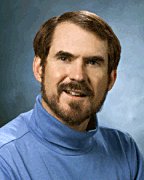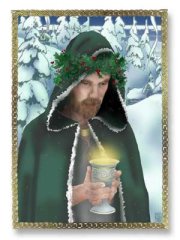Reprinted from Massage Today,
January 2002 (Vol. 2, Num. 1)
P.O. Box 6070 Huntington Beach, CA 92615 •USA
 |
|
The RamblemuseSMKeith Eric Grant, Ph.D. |
Myth and Magic
There are places in this world that are neither here nor there, neither up nor down, neither real nor imaginary. These are the in-between places, difficult to find and even more challenging to sustain. Yet they are the most fruitful places of all. For in these limited narrows a kind of life takes place that is out of the ordinary, creative, and once in a while genuinely magical. We tend to divide life between mind and matter and to assume that we must be in one or the other or both. But religion and folklore tell of another place that is often found by accident, where strange events take place, and where we learn things that can't be discovered in any other way. — Thomas Moore 8.
 In
ages past, the rhythms of our ancestors' lives were closely bound to the changing
cycle of the seasons. The coming of the New Year was linked with celebration
of the winter solstice, the point in the progression of celestial events that
marks both the shortest day and the birth of hope that a new spring will come.
Anglo-Celtic mythology metaphorically portrays the cycle of seasons as a recurring
conflict between the Holly King, who reigns during the half-year of waning
sunlight, and his brother the Oak King, who reigns during the half-year of
waxing sunlight. In their midwinter clash, the Holly King yields to the Oak
King even as the old sun dies so that the new sun can be reborn. As deep winter
approaches, the Holly King withdraws into contemplation. Within his chalice
he nurtures the nascent new sun and perhaps sees visions and dreams of the
year to come 10.
In
ages past, the rhythms of our ancestors' lives were closely bound to the changing
cycle of the seasons. The coming of the New Year was linked with celebration
of the winter solstice, the point in the progression of celestial events that
marks both the shortest day and the birth of hope that a new spring will come.
Anglo-Celtic mythology metaphorically portrays the cycle of seasons as a recurring
conflict between the Holly King, who reigns during the half-year of waning
sunlight, and his brother the Oak King, who reigns during the half-year of
waxing sunlight. In their midwinter clash, the Holly King yields to the Oak
King even as the old sun dies so that the new sun can be reborn. As deep winter
approaches, the Holly King withdraws into contemplation. Within his chalice
he nurtures the nascent new sun and perhaps sees visions and dreams of the
year to come 10.
Such shared myths as the Holly King encapsulate the themes by which a society makes sense of and responds to the world around it. Whether or not a myth has literal truth is often irrelevant to this metaphorical function. Similarly, we also share family myths and create personal myths to help us organize and make sense of the progression of our own lives 1,3,4,6. Because our attitudes and responses towards life take form within our internal stories, our personal myths can be both powerful and limiting. Often enacted at an unconscious level, they can separate us from the vitality of our embodied life or allow us to fully experience and draw upon that vitality. In the process, our personal myths set the underlying tone of our emotions and mental imagery. These emotions and imagery, in turn, profoundly affect our health and bodily comfort 2,9.
If posture and thought process are intimately connected, then, in a sense, your thoughts are constantly sculpting your posture, changing your alignment. The reverse holds true as well. Your posture influences your thinking. Your thoughts are part of a powerful matrix that influences your posture. The flood of words and images around you affect the way you sit, stand, and walk. … Both the pictures and the words in our minds influence the feelings in our bodies, which in turn feed our thoughts and mental pictures. — Eric Franklin 2
Among the conceptual difficulties in trying to approach the efficacy of massage and bodywork in the medical sense are the myriad ways in which we can, simply by presence and touch, influence internal life scripts, mental imagery, sensation, and even sense of identity. We deal not with simple cause and effect. Instead, we interact within the ever-changing flow of complex patterns of feedback. The concepts of personal myth and imagery outlined above provide a helpful perspective. Such thoughts are furthered by recent research into phantom limb pain that has led to a hypothesis that the brain contains widely distributed neural networks that create an image of self through genetic programs and memories of past experience. Afferent inputs act on this neuromatrix and produce output patterns that lead to the report of pain 5,7. What emerges is a view of the body as a system with a memory that accepts and responds to sensory input, but does not necessarily directly echo it either in form or timing.
The Celts viewed liminal (threshold) times and places -- times and places that are neither this nor that but contain a protean element of confusion and chaos -- as holding great potential for creation and change. The Chinese ideogram for crisis also succinctly captures this belief, being made up of the two symbols for danger and opportunity. Perhaps within our practice of bodywork, we learn to elicit the creation of such liminal moments of chaos and reorganization — a threshold or pause in what was a constant state of dysfunction that allows a client to move themselves towards wholeness and a new homeostasis. Our inputs of touch, sensation, and presence may well affect personal myth, imagery, emotion, and neurological state, facilitating such a reorganization of body and spirit. While this viewpoint is largely conjectural, it is conjecture firmly grounded in current concepts of human physiology and its web of interconnections.
Within ourselves, we have the need to create myths for our lives and work that provide us with the opportunity to experience and express wonder and marvel and to seek and find renewal. When these qualities flow into our work, they are conveyed and perceptible to our clients. As we enter into this New Year, there is no better way to promote your excitement with your practice of massage and to work out the creation of your own myth and magic.
Artwork of the Holly King is by Joanna Powell Colbert. Used with permission. This and other artwork of great magic and beauty can be found at http://www.jpc-artworks.com/
References
1. Feinstein, David and Stanley Krippner, 1997: The Mythic Path, J. P. Tarcher, ISBN 0-8747-7857-3.
2. Franklin, Eric, 1996: Dynamic Alignment Through Imagery, Human Kinetics, ISBN 0-87322-475-2.
3. Keen, Sam, and Anne Valley-Fox, 1989: Your Mythic Journey, J. P. Tarcher, ISBN 0-8747-7543-4
4. Keleman. Stanley, 1999: Myth & the Body, Center Press, ISBN 0-9343-2017-9.
5. John D Loeser, Ronald Melzack, 1999: Pain: an overview, The Lancet, 353, pp. 1607-1609.
6. McAdams, Dan P., 1997: The Stories We Live By, Guilford Press, ISBN 1-5723-0188-0.
7. Melzack R., 1993: Pain: past, present and future, Canadian J. Exp. Psychol., 47(4), pp. 615-29
8. Moore, Thomas, 2000: Neither Here nor There, Parabola, 25(1), pp. 34-37. http://www.parabola.org/magazine/backissues/2501/2501-1.html
9. Rossi, Ernest Lawrence, 1993: The Psychobiology of Mind-Body Healing, revised ed., W. W. Norton, ISBN 0-3937-0168-9.
10. The psychosomatic importance of the containing vessel archetype is explored in: van der Giessen, Matthew J., Sacred Vessel I & II, http://www.somaticartsinstitute.com/mvdg/vessel1.html and http://www.somaticartsinstitute.com/mvdg/vessel2.html